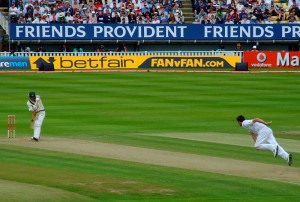
It’s Michael Clarke’s first test series since getting married to Kyly Boldy, and back-to-back double tons is a testament to having a happy off-field lifestyle.
Yet critics will continue to question his merit as one of the game’s greatest while he makes his runs batting at number five, but the statistics show that Pup is batting under just as much, if not more pressure than Ricky Ponting did at his peak.
His predecessor is no doubt one of the greatest of all time, averaging 52.21 runs from a 167-test career, including 41 centuries and a high score of 257.
Experts say batting at first drop is the toughest position to bat, coming in usually when the ball is still brand new and swinging, and straight after the first wicket of the innings.
A good batter comes in at three and steadies the ship. Ponting has done so countless times for the baggy green.
The argument against Clarke however is that he is batting down the order when the runs are already on the board and the pressure is off.
The argument in general has merit, yet critics must realise that Australia’s top order is not what it once was, especially not since the Langer-Hayden period.
It would be a fair assumption to make if Clarke was coming in at 3-150, facing a ball that’s 30 overs old, on a pitch that has flattened out over a warm morning session.
Yet, the skipper is time and time again saving an Australian innings, no different to when Ponting at his peak would come in at number three.
Here’s a comparison to the pair’s top 3 career scores.
Ricky Ponting’s top 3 scores:
257 v India, 2003. Ponting came in at 1-30, in the 7th over.
242 v India, 2003. Ponting came in at 1-22, in the 6th over.
221 v India, 2012. Ponting came in at 2-31, in the 11th over.
Michael Clarke’s top 3 scores:
329* v India, 2012. Clarke came in at 3-37, in the 9th over.
259* v South Africa, 2012. Clarke came in at 3-40, in the 10th over.
224* v South Africa, 2012. Clarke came in at 3-55, in the 14th over.
According to those stats above, you could assume the ball would still be relatively new and still swinging in both situations. Yet, is there more pressure batting at number three or number five? Against India in 2003, Ponting came in at 1-30, and went on to make 257. Clarke last summer came in at 3-37 (which I would argue is even more pressure than batting at first drop), and saved the innings, going onto make 329 not out.
Despite what number Clarke is batting at, the other question mark on his batting is his ability to score runs at a consistent rate.
Yes, Ponting has played nearly double the amount of test cricket than Michael Clarke has, but the current captain has played more than enough cricket to be regarded with the best.
The Pup has played 85 test matches, is currently 26th on the all-time test batting averages, behind Ricky Ponting ranked 25th. If you remove the players that played less than 50 test matches in their career, then Clarke and Ponting would be 16th and 15th respectively.
Greg Chappell, ranked 2nd in Australian test batting averages behind Sir Don Bradman, played 87 tests for an average of 53.86. Not much difference to Clarke’s 85 tests for 52.15.
Back in favour with Clarke is the argument that since taking over the captaincy, his batting has improved. Whether or not it is him relishing the leadership or simply taking responsibility for the team’s batting performance, there is no doubt the captaincy has improved his batting.
Since taking over the captaincy in August, 2011, Clarke has averaged 75.28 with the bat, including three centuries, three double tons and a triple century, all in the space of 15 months.
In this calendar year alone, Clarke is averaging 119 from 11 tests. The only player to average more in a calendar year* is Sir Garfield Sobers (144.33 in 1958) (*must have scored 1000 runs in the calendar year). Ponting’s best calendar year was 2003, at an average of 100.20. Bradman averaged 113.88 in 1948.
The statistics are compellingly strong in Clarke’s favour, and at 31 years old, you would suggest he still has a few years ahead of him before he is ultimately ranked as one of the best in the history of the game.
And yes, there may be a time when Clarke moves up the order to number four or three, however with things going so well for the Pup, that change won’t be made this summer.
Yet, 2012 will be remembered as one of the best calendar years of any individual cricketer ever, and a win (and maybe another century) in the next test against South Africa giving Australia back the number one test ranking, would cap off the perfect year for Michael Clarke.
Damien Ractliffe is a graduating Bachelor of Journalism student at La Trobe University. You can follow him on Twitter: @DamienRactliffe.






